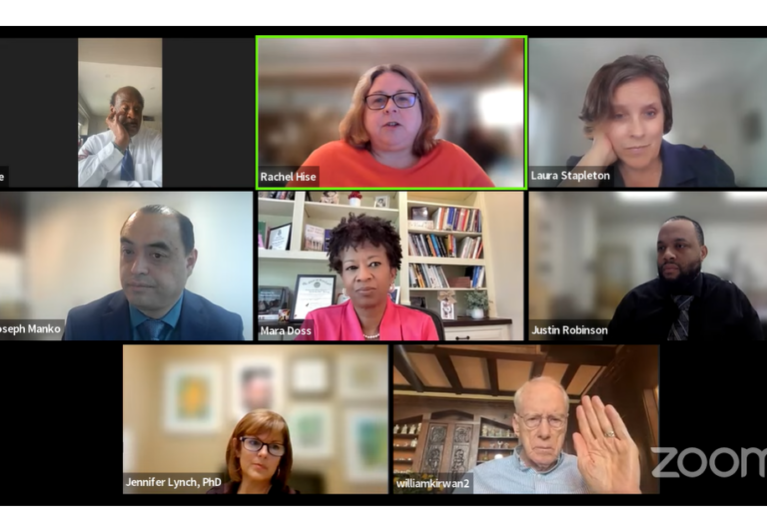Sunshine Week: What Maryland school systems make easy — or difficult — to learn about them

For Sunshine Week, an annual national celebration of open government, the Maryland-Delaware-D.C. Press Association examined public school system websites to assess how easy it is to get key information about public schools in the three jurisdictions. MDDC looked at websites in D.C., all 23 counties and the city of Baltimore in Maryland, and four large school systems in Delaware. The project was led by former Washington Post reporter Miranda S. Spivack, with editing by Frederick News-Post editor Andrew Schotz and contributions from MDDC executive assistant Samantha Savage. Reporters George Berkheimer of The Business Monthly; Sabrina LeBoeuf and Lillian Reed of The Baltimore Sun; and Darryl Kinsey Jr. and Caleb Soptelean of Southern Maryland News also contributed research.
Public school systems in Maryland, Delaware, and Washington, D.C., generally do well sharing basic information on their websites, such as how to contact the superintendent or when the next school board meeting will be held.
But finding information on school websites about teacher and superintendent salaries, the amount spent per pupil, or the amounts of contracts with outside vendors can be a challenge.
The Maryland-Delaware-D.C. Press Association examined 29 public school system websites in the three jurisdictions. The press association looked for basic public information, such as email addresses and phone numbers, as well as more detailed data, such as school district budgets and copies of contracts.
MDDC found that most school systems make it easy to check in on school board meetings — all of them livestream their sessions. But in many systems, getting agenda packets the board would analyze at an upcoming meeting or figuring out ongoing expenditures for a school renovation proved more difficult.
Websites that anticipate and answer questions, such as from prospective parents or teachers, can help the public more easily find information about how the school system functions. An informative website can reduce the number of public records requests, saving time and money, because the information is already posted.
The information can be useful to families deciding where to live and enroll their children. It can help teachers decide where to apply for a position.
“Proactively, it helps parents. They see what schools they want to put their kids in,” said David Cuillier, a journalism professor who was recently named director of the Joseph L. Brechner Freedom of Information Project at the University of Florida.
Cuillier said studies show that when school systems post information about their performance records and other data, it can influence future performance, as well as the school systems that families choose. Parents, he said, “notice that and take action based on that.”
All U.S. states, territories and the District of Columbia have their own public records and public meetings laws that require certain levels of transparency across state and local governments, including public school systems. The laws have a lot in common.
But a family may not have time, money or expertise to use those laws to research a school system. They look for quick, readily available information — and the school system website is a likely stop in their search.
Getting information through a formal public records request can take weeks, depending on the focus of the request and the timetables allowed by law.
In Delaware, it can be more complicated. The state allows its agencies to reject requests from non-residents. (The decision by some states to provide public records only to residents, or, in some places, only to U.S. citizens living in that state, was unanimously upheld by the U.S. Supreme Court in 2013 in McBurney v. Young).
With those limitations in mind, MDDC looked at the information school systems publicly share on their websites, without requiring someone to contact the school system by phone or email, or through a formal public records request. It is a mixed picture.
MDDC used a checklist of 20 types of information, starting with basic details such as email addresses, phone numbers and addresses.
Items on the checklist ranged from how to contact school board members and school system CEOs or superintendents to who the outside contractors are and how much they are paid.
Another question was how much each system spends per pupil — a useful metric for families deciding where to send children to school but one particularly difficult to find from the school system.
MDDC looked for school board agendas and packets of information that explain agenda items.
MDDC checked if school board meetings were live streamed and if videos were archived.
MDDC searched for written minutes of school board meetings, which some systems post on their websites.
The mixed bag in finding accessible information on school system websites is common.
Cuillier, the journalism professor, said education systems at the state and local levels are among the least transparent in state and local government. Making a formal records request may not work out well.
“Study after study shows education is secretive. If you want records you are entitled to, you are likely to only get those records about half the time,” he said.
There are many reasons school systems can be skittish about disclosing information, even when required by law.
First, there is a cautious culture in governments because people who fulfill information requests are leery of disclosing information they should not.
In school systems, people responding to information requests are mindful of the federal Family Educational Rights and Privacy Act (FERPA), which requires that certain information be kept private or only provided to a student’s family.
Depending on local law, people responding to records requests can be sued for errors. Thus, there is often a culture inside governments of “When in doubt, don’t give it out.”
Adding to concerns about making mistakes, school systems often are at the center of hot-button issues, such as disputes about curriculum, books in schools’ libraries or a teacher’s syllabus.
Book-ban debates have occurred recently in Maryland in several jurisdictions. Delaware also has seen several book challenges. D.C. public school librarians are keeping a watchful eye on how these disputes play out.
Rick Weldon, a former Republican state lawmaker from Frederick County, now president and CEO of the Frederick County Chamber of Commerce, has broad experience in state and local government.
He said county commissions, town councils and school boards tend to ignore requirements for transparency to act quickly and expediently to get their agendas done.
In many smaller communities, elected officials are part-timers, and need to get up early the next day for their day jobs. The tendency, Weldon said, is to push forward on an agenda, even when more time may be needed for public input or more detailed disclosure.
They do this, he said, not with the nefarious goal of keeping the public in the dark — although he acknowledges that is sometimes the case — but “in the interest of being efficient and getting work done quickly.”
School boards, in particular, have substantial influence over large budgets, but are not well compensated for their work or time.
In Montgomery County, Md., for instance, the annual public school operating budget without the capital or construction budget is about $3 billion.
Members of the Montgomery County school board are paid $25,000 annually, with a $4,000 boost for the president.
By contrast, members of the Montgomery County Council are paid $156,284. The council president is paid $171,912.
But, often, school board members meet nearly as often as a County Council or Commission. They help manage a budget that is approximately half of the jurisdiction’s expenditures and what can be a sprawling system with hundreds or thousands of employees.
Many school boards that MDDC reviewed use a software system known as BoardDocs to manage meetings, agendas and other documents.
But how they use BoardDocs can differ greatly.
Some districts use it to store documents that can then be searched by someone looking for information. Others use it to provide an advance agenda for board meetings.
Some of those that were part of the review use BoardDocs to post written minutes. For those that do not, someone looking for a specific issue or discussion must search an archived video of the board meeting. Some archived videos have the agenda scrolling alongside the video, which helps the search.
The bottom line: The majority of the school systems that MDDC looked at could do better at sharing important information, such as budgets and contracts, on their websites.
Some of MDDC’s key findings:
Getting in touch with school board members:
If you want to reach the board of education, which oversees the school system and hires and fires the superintendent, contact information is easily findable on most school system websites — and most provide contact emails for individual board of education members.
Two of those surveyed, Baltimore City schools, and St. Mary’s County schools, do not provide contact emails for board members in an obvious place on their websites. They do provide a general email address. Baltimore City schools provide email addresses and a phone number for the board staff. St. Mary’s provides a phone number and a fax number for the board of education, but no email addresses that were obvious. At the bottom of the website, a “contact us” link leads to a list of school system offices, but not the board of education.
Can I watch a school board meeting from my living room?
All of the school systems surveyed livestream their school board meetings, using platforms such as Zoom and YouTube.
Written minutes of board of education meetings are rarely posted.
About half of the school systems do not post written minutes; some assert that their video archive of school board meetings should suffice. Some archives are annotated, usually with the agenda scrolling alongside the video, so viewers can look for what they are seeking.
Can I find my school system’s annual operating budget?
All of the school systems post their operating budget documents. But figuring out the total spending plan can be difficult.
Some systems put the amount up front in the budget document; others give the total many pages later.
Importantly, many budget documents do not pop up by searching “budget” in the website’s search function.
That, for instance, was the case for Dorchester County, Md.’s public school system website. The budget is posted at https://dcps.k12.md.us/leadership/b-o-e/budgets, which can be found through a Google search, but can’t be found through the website search function.
In the District of Columbia, the public schools website has budget information in a pie chart. Unlike many school systems, D.C. Public Schools provides a useful school-by-school budget.
How much does the school system spend per pupil?
This metric is difficult to find. In Maryland, it is on a different website from the local school systems’ websites — that of the Maryland State Board of Education. In D.C., the data can be found on the website of the Office of the State Superintendent of Education. Similarly, in Delaware, the data is on the website of the state Office of Elementary and Secondary Education.
What do school systems pay their teachers?
For almost all of the school systems, MDDC easily found teacher salary information on the district websites through contracts that were posted.
What does the superintendent get paid and what’s in the contract?
This is widely available if someone makes a direct request, and sometimes through reporting by local news organizations after a superintendent is hired. But contracts don’t always show up when you search for “superintendent contract” on websites. In Baltimore City, Baltimore County, Calvert, Charles, Frederick, Howard, Montgomery, Prince George’s, and St. Mary’s counties in Maryland, the superintendent’s contract was easy to find.
Who is the school system contracting with for construction and other capital projects? How much is it spending on each contract?
About a third of the 29 school systems post at least some information about contracts. If others post contract details, they are not easy to find through website search bars.
Best practices for school officials, boards
Bonnie Leedy, founder and CEO of Schoolwebmasters.com, a commercial software company that sells to school systems, has compiled a list of best practices for school system transparency.
Among the recommendations:
“There is a purpose, a value, a goal behind every major decision,” she wrote in a blog post.
The rationale or the “why” should be publicly discussed.
Information “trumps rumors.” Be proactive. Don’t wait for something to blow up.
“Sometimes you don’t have a choice and must react in an unexpected crisis. But when you maintain consistent transparency, those times are the exceptions,” Leedy wrote in the blog post.
And do a good job with your website: “Establish reliable channels of communication that are continually updated and informative. Your school website should be the communications hub from which everything else radiates, including social media, newsletters, parent notification systems, local media articles, employee intranets, governing board meetings, parent e-mails, staff e-mails, local TV channels, etc.,” Leedy recommended.
Be comfortable with pushback and be prepared for conflict. Saying nothing when a problem arises causes the public to be suspicious and wonder what you are hiding.
In an interview, Leedy said school systems are often reluctant to openly discuss the rationale behind their decisions, but that unwillingness often backfires.
While she understands the reluctance, especially in this era of hot-button issues and widespread use of social media by critics, she said, the best move a school system can make is to be upfront about how and why its officials reached a decision.
“You have a reason for making the decision you are making,” she said. “If it is well thought out, and you can express it clearly, a majority will at least say, ‘I can respect it for the analysis or presentation,’” even when they disagree, she said.
“Tell them the ‘why.’ That is my preaching. What has hurt that is self-censorship,” she said.




 Creative Commons Attribution
Creative Commons Attribution